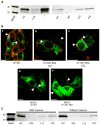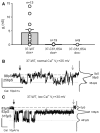Extracellular loop cysteine mutant of cx37 fails to suppress proliferation of rat insulinoma cells
- PMID: 22797939
- PMCID: PMC3527626
- DOI: 10.1007/s00232-012-9459-x
Extracellular loop cysteine mutant of cx37 fails to suppress proliferation of rat insulinoma cells
Abstract
Although a functional pore domain is required for connexin 37 (Cx37)-mediated suppression of rat insulinoma (Rin) cell proliferation, it is unknown whether functional hemichannels would be sufficient or if Cx37 gap junction channels are required for growth suppression. To test this possibility, we targeted extracellular loop cysteines for mutation, expecting that the mutated protein would retain hemichannel, but not gap junction channel, functionality. Cysteines at positions 61 and 65 in the first extracellular loop of Cx37 were mutated to alanine and the mutant protein (Cx37-C61,65A) expressed in Rin cells. Although the resulting iRin37-C61,65A cells expressed the mutant protein comparably to Cx37 wild-type (Cx37-WT)--expressing Rin cells (iRin37), Cx37-C61,65A expression did not suppress the proliferation of Rin cells. As expected, iRin37-C61,65A cells did not form functional gap junction channels. However, functional hemichannels also could not be detected in iRin37-C61,65A cells by either dye uptake or electrophysiological approaches. Thus, failure of Cx37-C61,65A to suppress the proliferation of Rin cells is consistent with previous data demonstrating the importance of channel functionality to Cx37's growth-suppressive function. Moreover, failure of the Cx37-C61,65A hemichannel to function, even in low external calcium, emphasizes the importance of extracellular loop cysteines not only in hemichannel docking but also in determining the ability of the hemichannel to adopt a closed configuration that can open in response to triggers, such as low external calcium, effective at opening Cx37-WT hemichannels.
Figures






Similar articles
-
Structural determinants and proliferative consequences of connexin 37 hemichannel function in insulinoma cells.J Biol Chem. 2014 Oct 31;289(44):30379-30386. doi: 10.1074/jbc.M114.583054. Epub 2014 Sep 12. J Biol Chem. 2014. PMID: 25217644 Free PMC article.
-
Carboxy terminus and pore-forming domain properties specific to Cx37 are necessary for Cx37-mediated suppression of insulinoma cell proliferation.Am J Physiol Cell Physiol. 2013 Dec 15;305(12):C1246-56. doi: 10.1152/ajpcell.00159.2013. Epub 2013 Oct 16. Am J Physiol Cell Physiol. 2013. PMID: 24133065 Free PMC article.
-
Connexin 37 profoundly slows cell cycle progression in rat insulinoma cells.Am J Physiol Cell Physiol. 2008 Nov;295(5):C1103-12. doi: 10.1152/ajpcell.299.2008. Epub 2008 Aug 27. Am J Physiol Cell Physiol. 2008. PMID: 18753315 Free PMC article.
-
Emerging issues of connexin channels: biophysics fills the gap.Q Rev Biophys. 2001 Aug;34(3):325-472. doi: 10.1017/s0033583501003705. Q Rev Biophys. 2001. PMID: 11838236 Review.
-
Regulation of connexin hemichannel activity by membrane potential and the extracellular calcium in health and disease.Neuropharmacology. 2013 Dec;75:479-90. doi: 10.1016/j.neuropharm.2013.03.040. Epub 2013 Apr 12. Neuropharmacology. 2013. PMID: 23587648 Review.
Cited by
-
Structural determinants and proliferative consequences of connexin 37 hemichannel function in insulinoma cells.J Biol Chem. 2014 Oct 31;289(44):30379-30386. doi: 10.1074/jbc.M114.583054. Epub 2014 Sep 12. J Biol Chem. 2014. PMID: 25217644 Free PMC article.
-
Extracellular Cysteines Are Critical to Form Functional Cx46 Hemichannels.Int J Mol Sci. 2022 Jun 29;23(13):7252. doi: 10.3390/ijms23137252. Int J Mol Sci. 2022. PMID: 35806258 Free PMC article.
-
Serine 319 phosphorylation is necessary and sufficient to induce a Cx37 conformation that leads to arrested cell cycling.J Cell Sci. 2020 Jun 18;133(12):jcs240721. doi: 10.1242/jcs.240721. J Cell Sci. 2020. PMID: 32350069 Free PMC article.
-
Carboxy terminus and pore-forming domain properties specific to Cx37 are necessary for Cx37-mediated suppression of insulinoma cell proliferation.Am J Physiol Cell Physiol. 2013 Dec 15;305(12):C1246-56. doi: 10.1152/ajpcell.00159.2013. Epub 2013 Oct 16. Am J Physiol Cell Physiol. 2013. PMID: 24133065 Free PMC article.
-
The lipidated connexin mimetic peptide SRPTEKT-Hdc is a potent inhibitor of Cx43 channels with specificity for the pS368 phospho-isoform.Am J Physiol Cell Physiol. 2019 Oct 1;317(4):C825-C842. doi: 10.1152/ajpcell.00160.2019. Epub 2019 Jul 31. Am J Physiol Cell Physiol. 2019. PMID: 31365296 Free PMC article.
References
-
- Bao X, Chen Y, Reuss L, Altenberg GA. Functional expression in Xenopus oocytes of gap-junctional hemichannels formed by a cysteine-less connexin 43. J Biol Chem. 2004;279:9689–9692. - PubMed
-
- Beahm DL, Oshima A, Gaietta GM, Hand GM, Smock AE, Zucker SN, Toloue MM, Chandrasekhar A, Nicholson BJ, Sosinsky GE. Mutation of a conserved threonine in the third transmembrane helix of alpha- and beta-connexins creates a dominant-negative closed gap junction channel. J Biol Chem. 2006;281:7994–8009. - PubMed
-
- Bednarczyk D, Mash EA, Aavula BR, Wright SH. NBD-TMA: a novel fluorescent substrate of the peritubular organic cation transporter of renal proximal tubules. Pflugers Arch. 2000;440:184–192. - PubMed
-
- Burt JM, Fletcher AM, Steele TD, Wu Y, Cottrell GT, Kurjiaka DT. Alteration of Cx43:Cx40 expression ratio in A7r5 cells. Am J Physiol Cell Physiol. 2001;280:C500–C508. - PubMed
Publication types
MeSH terms
Substances
Grants and funding
LinkOut - more resources
Full Text Sources
Research Materials
Miscellaneous

